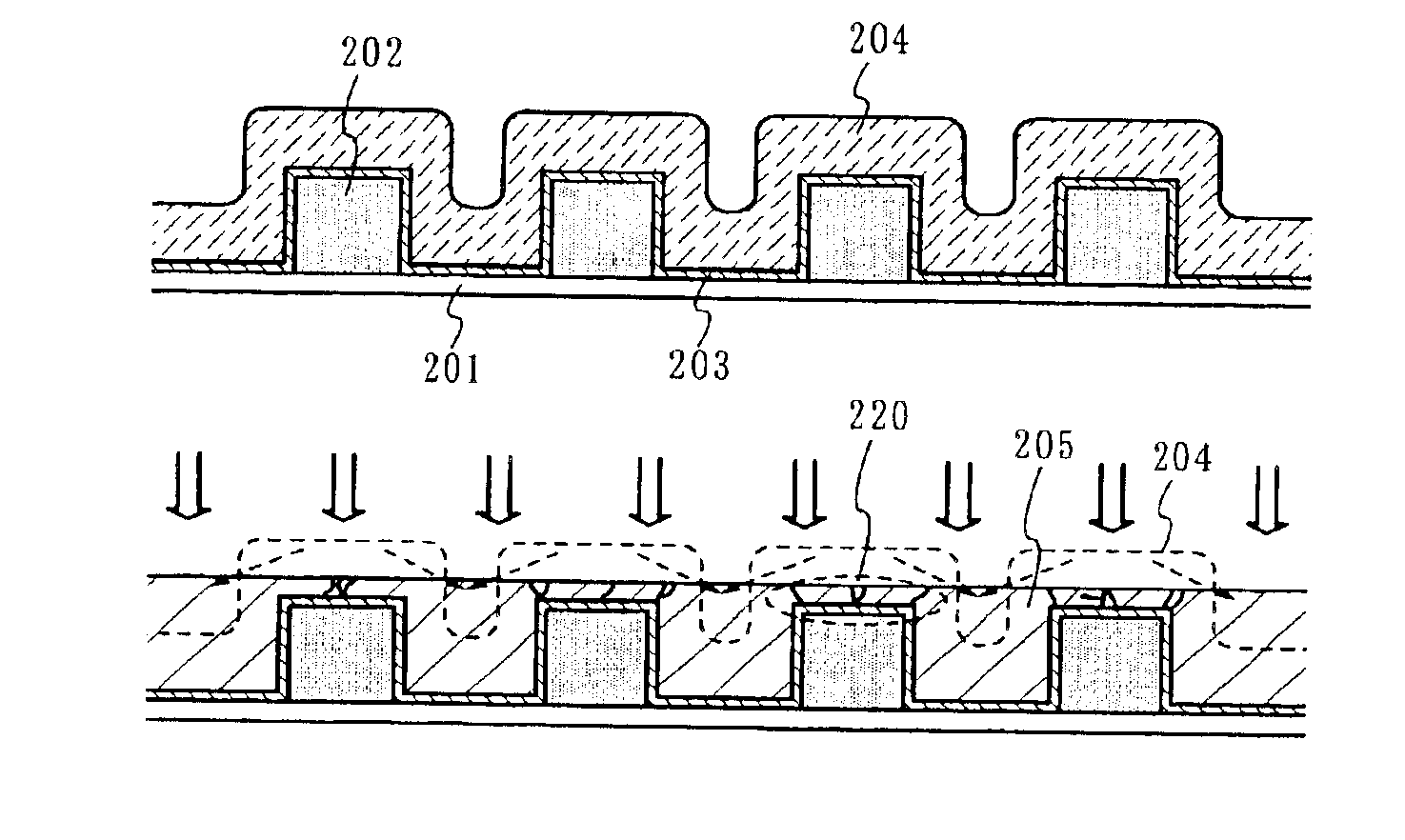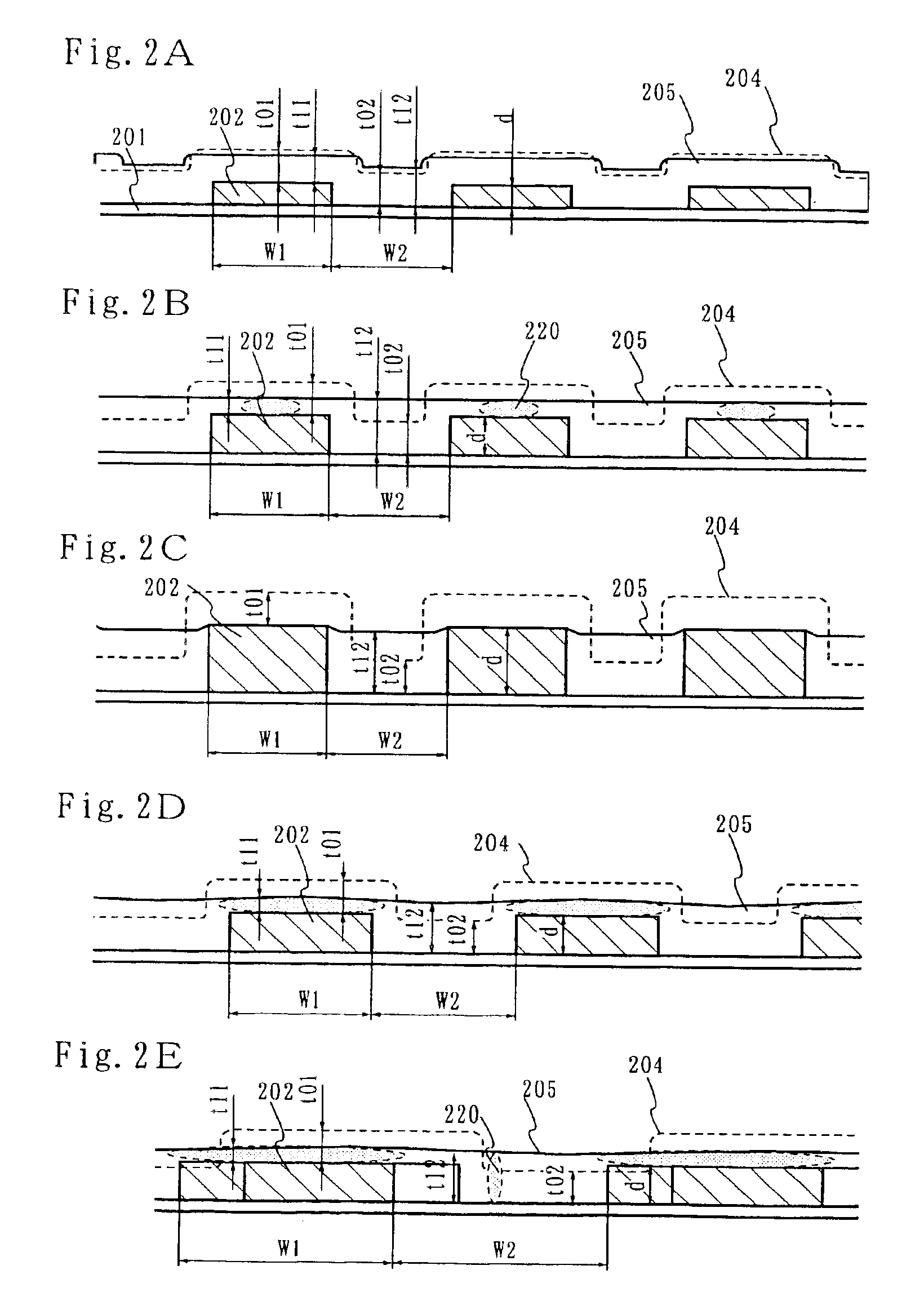Semiconductor device and method of manufacturing the same
a semiconductor film and semiconductor technology, applied in the direction of semiconductor devices, electrical equipment, transistors, etc., can solve the problems of forming defects such as grain boundaries, polycrystals, and obtaining polycrystals,
- Summary
- Abstract
- Description
- Claims
- Application Information
AI Technical Summary
Benefits of technology
Problems solved by technology
Method used
Image
Examples
embodiment 1
[0097]Referring to FIGS. 1A to 1E, explanations will be given on the above-described mode of the present invention. FIGS. 1A to 1E are vertical sectional views illustrating a process of forming a crystalline semiconductor film of the present invention.
[0098]In FIG. 1A, a first insulating film 201 is formed to a thickness of 30 to 300 nm from silicon nitride, silicon oxynitride whose nitrogen content is larger than its oxygen content, aluminum nitride, or aluminum oxynitride. On the first insulating film 201, a second insulating film 202 is formed from silicon oxide or silicon oxynitride to a thickness of 10 to 1000 nm , preferably 50 to 200 nm . The second insulating film 202 has openings having a desired shape. A desired shape may be a rectangle, a circle, a polygon, a belt, or a shape matching the shape of an island-like semiconductor film (active layer) of a TFT to be manufactured. A silicon oxide film can be formed by plasma CVD using a mixture of tetraethyl ortho silicate (TEOS...
embodiment 2
[0116]In forming a crystalline semiconductor film of the present invention, an amorphous semiconductor film crystallized by laser light irradiation as shown in Embodiment 1 may be further irradiated with laser light to melt the film again for re-crystallization.
[0117]FIGS. 3A to 3E show an example thereof. First, a first insulating film 201, a second insulating film 202, a silicon oxynitride film 203, and an amorphous semiconductor film 204 are formed in the manner described in Embodiment 1. The amorphous semiconductor film 204 is doped with Ni as a metal element having catalytic functions for accelerating crystallization, such as lowering the crystallization temperature of silicon and improving the orientation. How the film is doped with Ni is not limited and spin coating, evaporation, sputtering, or other methods can be employed. When spin coating is used, an aqueous solution containing 5 to 10 ppm of nickel acetate is applied to form a metal element-containing layer 210. The cata...
embodiment 3
[0122]This embodiment gives a description with reference to FIGS. 4A to 10F on a mode of manufacturing a TFT whose channel formation region is placed in a filling region. The filling region is a region of a crystalline silicon film that fills an opening of a base insulating film that is formed under the crystalline silicon film. FIG. 4A is a top view whereas FIGS. 4B and the subsequent drawings are vertical sectional views of various portions of FIG. 4A.
[0123]Similarly, FIGS. 5A, 6A, 7A, 8A, 9A, and 10A are top views whereas the rest are vertical sectional views.
[0124]In FIGS. 4A to 4E, a silicon nitride film or aluminum oxynitride film with a thickness of 30 to 300 nm is formed as a first insulating film 302 on a glass substrate 301. On the first insulating film 302, a silicon oxide film or a silicon oxynitride film is formed and subjected to photo etching to form a second insulating film 303 that has rectangular patterns. A silicon oxide film with a thickness of 1000 nm is formed ...
PUM
 Login to View More
Login to View More Abstract
Description
Claims
Application Information
 Login to View More
Login to View More - R&D
- Intellectual Property
- Life Sciences
- Materials
- Tech Scout
- Unparalleled Data Quality
- Higher Quality Content
- 60% Fewer Hallucinations
Browse by: Latest US Patents, China's latest patents, Technical Efficacy Thesaurus, Application Domain, Technology Topic, Popular Technical Reports.
© 2025 PatSnap. All rights reserved.Legal|Privacy policy|Modern Slavery Act Transparency Statement|Sitemap|About US| Contact US: help@patsnap.com



